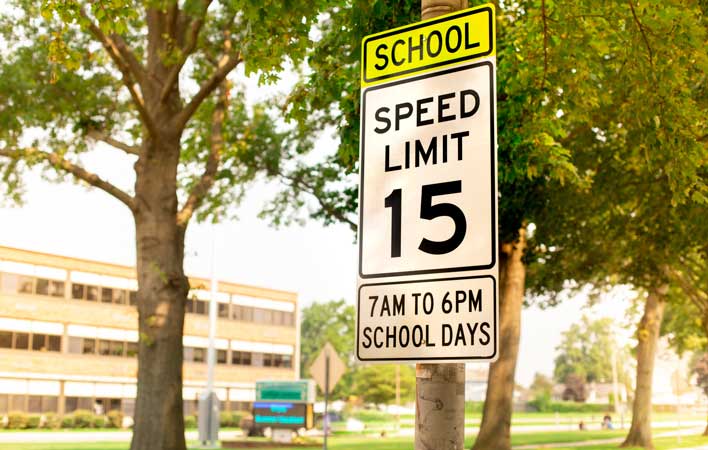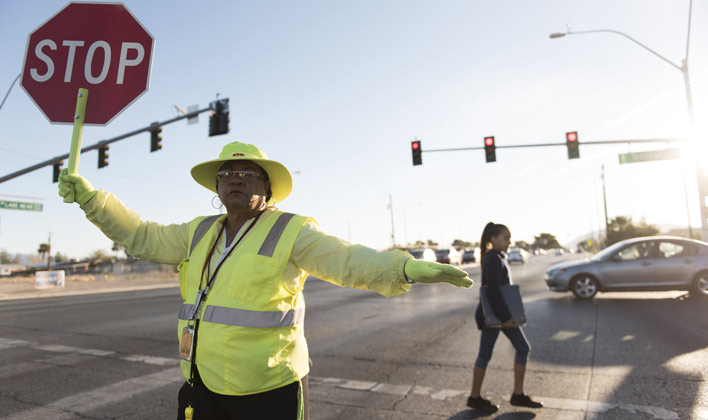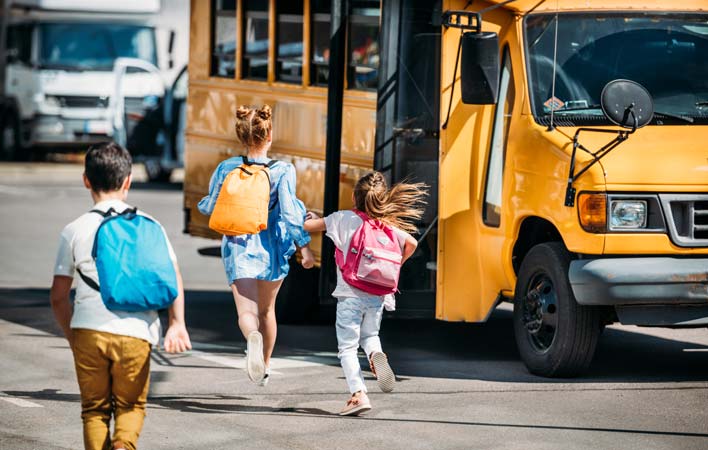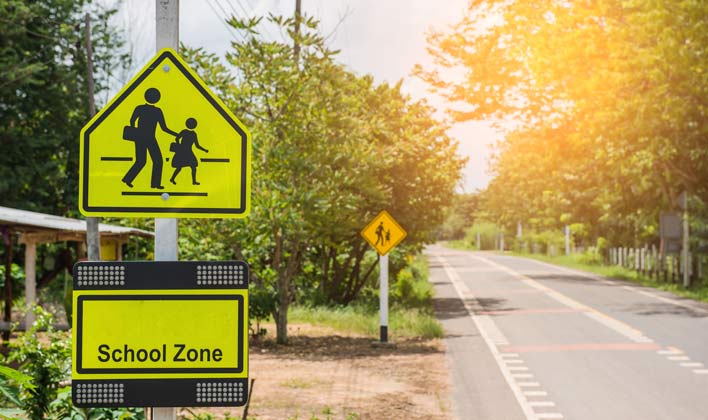It’s back to school safety time! Do you know the rules of the road to keep kids safe as they’re traveling to and from school?
Younger children can be unpredictable, and often don’t understand the danger of walking near automobiles. Better safety awareness and safer automotive features have reduced child pedestrian deaths overall, but teen pedestrian deaths have increased with the advent of cell phone usage, due to distracted pedestrian behavior.
According to Safe Kids Worldwide, more child pedestrians are hit by cars in September than any other month of the year. In 2015, 456 American kids died from pedestrian injuries. In 2014, there were 40,000 children in the U.S. non-fatally injured as pedestrians.
As we approach the start of the school year, here are seven safety tips to protect kids on the road:
1. Know where the school zones are located on your daily commute.
School zones are usually well-marked with warning signs, speed bumps and/or flashing lights. Check out the websites for public school districts in your area for more information. Keep your eyes open for school zone signs. Make a note of the speed limits and the location of pedestrian crosswalks, and drive carefully until you are out of the area.

2. If you can, reroute your commute to avoid school zones.
We all become distracted while driving to and from work, or sometimes run late and feel the need to skirt traffic laws. Too often, we’re also commuting when children are walking to school. So, it’s safer to simply avoid school zones altogether. This also helps reduce traffic congestion around school areas.
3. If you can’t avoid school zones, SLOW DOWN and PAY ATTENTION
If you must drive through a school zone, leave a little early and drive slower. Penalties for breaking traffic laws double, and sometimes triple, in school zones and around school buses. And the consequences of injuring or killing a child is unthinkable, especially if the accident was avoidable. It’s better to be a little late.
Depending on the school zone, this speed limit could be as low as 10, 15 or 20 miles per hour. Even if the speed limit is not displayed, when driving within 500-1000 feet of a school while children are present, the speed limit is 25 mph at the most.
Rectangular Rapid Flashing Beacons (RRFB) are an effective school zone safety solution that many communities have installed at high-risk intersections. However, even if there are no flashing lights, remember that pedestrians always have the right-of-way. If a pedestrian is crossing the street, drivers must yield.
To ensure that you don’t violate the law or strike a child, avoid passing or changing lanes in a school zone. Also, put your distractions aside and give your full attention to the road.

4. Respect the school crossing guard
Schools with crossing guard programs typically place them at intersections where children are most at risk. A crossing guard is usually attired in a bright safety vest and carries a STOP sign. The crossing guard is the first person to step into the street, and the last person to step off the street.
If you see a crossing guard enter the street, know that children are likely to follow. Respect the guard’s authority and obey their directions. Stay in place until all pedestrians, and the guard, are safely on the other side of the road and the STOP sign is down.
5. Know the law about driving near school buses
In every state, it is against the law to pass a school bus when it is stopped to load or unload children. On undivided roads, cars traveling in both directions – those driving behind the school bus, and those driving toward the bus on the other side – must stop, and stay stopped, until the bus proceeds.
Some school buses flash yellow lights and may have an extending STOP sign so that all drivers are aware that children are entering or exiting the bus.
State laws vary about passing a school bus going the opposite direction on a divided road, so check your state’s school bus safety laws to be sure.

6. Follow the rules when picking up and dropping off children at school
When dropping their own children off or picking them up at school, it seems as though some parents forget all about the safety of other children.
When depositing or picking your kids up at school, use the designated drop off and pick up lanes, and drive slowly – that means less than 10 mph. Expect children to dart out between cars and be ready to hit the brake if they do.
If you will be more than a moment, then find a legal parking spot to keep the lane clear. The key word is legal: never park in a fire lane, emergency lane, or space designated for handicapped parking.
7. Even when not driving in school zones, be mindful of small pedestrians when school is in session.
When driving through residential neighborhoods, remember that the speed limit is the fastest you should be going. If children are present, you should be driving much slower.
Keep your eyes open for pedestrians and bicyclists, especially near schools and parks.
Come to a complete stop at stop signs and crosswalks, before the line. Don’t block crosswalks and force pedestrians to walk around you and into traffic. Make eye contact with pedestrians so you have a better sense of what they will do.
When backing out of a driveway or parking space, be alert for children. Don’t rely on your backup camera, as a fast-moving bicycle, skateboard, scooter, or even a running child, may not show up until it’s too late. Look over both shoulders to make sure the coast is clear, and back up slowly.
Be award that when making turns, it is easy to miss a pedestrian starting to cross. Before turning your car, turn your head to see the whole picture.
In cities, be sure to watch for pedestrians, especially children, darting out mid-block from between parked vehicles.
Do not pass a vehicle that stopped for pedestrians. You run the risk of hitting a pedestrian. If a car is stopped inexplicably, and you want to pass, do so slowly, and be prepared to stop.
Don’t honk at kids – it may upset them and cause them to react unpredictably and unsafely, for instance, run across lanes without making sure it’s safe to do so.
NEVER wave for a pedestrian to proceed, especially a child. You may not be able to see oncoming traffic coming from other directions, and your action may cause a person to cross unsafely and be hit. Be patient and allow pedestrians to determine when it is safe to cross.
If you’re a parent, teach your child to be a safe pedestrian when heading back to school, and drive safely yourself.
If your child has been injured in a pedestrian accident, TorkLaw can help you receive the compensation you need for your child’s recovery. We can handle the insurance companies, help you with doctor’s appointments and keep the bill collectors away, so that you can devote all your attention where it needs to be: on your child. Call us for a free, no obligation consultation: 888.845.9696.





